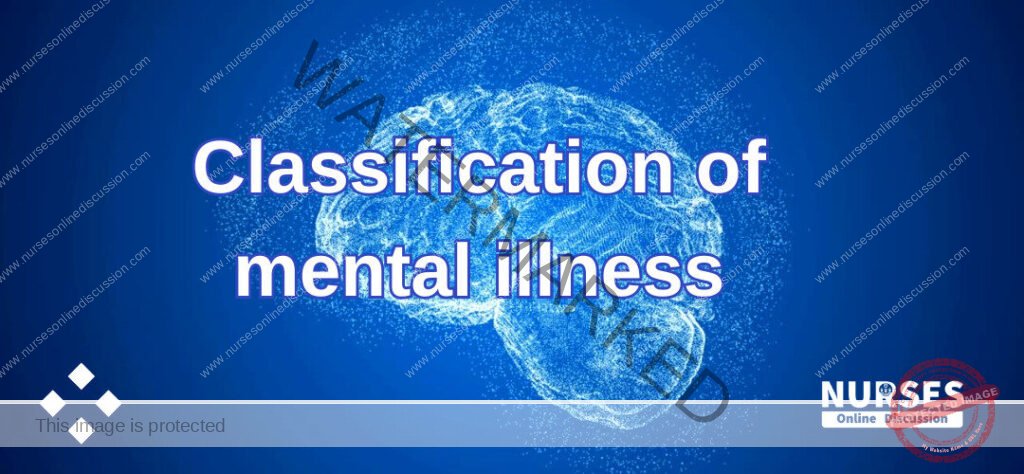Mental Health Nursing
Subtopic:
Classification of Mental health illness

CLASSIFICATION OF MENTAL ILLENESS
- The purpose of classifying is to identify groups of people/patients who share similar clinical features in order to have a suitable diagnosis mgt can be planned and likely outcome/prognosis is predictable
- It’s important to classify mental illness because it serves as a guide to Diagnosis and prognosis (outcome)
In psychiatry classification is based on clinical description of disease.
General classification
Neurosis
It means a group of mental disorder which have a combination of symptoms in which there’s is no evidence of organic brain disorder .People who suffer from those conditions don’t lose touch with the external reality ,the behavior may be affected but remains within socially acceptable limits.
In neuroses, there are no hallucinations and delusions.
Patients may have insight and seek help.
Examples of neurosis are:
Anxiety Disorders: occur in various combination of psychological and physical or symptoms. Anxiety is vague feeling, worry and tension characterized by excessive fear and apprehension.
Obsessive Compulsive disorder [OCD]: recurred, persistent thought, impulses or images that the pt regards as unwanted, while recognizing them as physical and dissociative problems
Phobic – fear
Panic – Extreme of fear.
PTSD [post – Traumatic stress Disorders]: This is a group of mental symptoms that usually follow a traumatizing experience like war, floods, and epidemics like Ebola, rape, defilement, and accident. The condition is characterized by severe anxiety persistent disturbing and reoccurring thought or night mares of the experience.
Conversion and dissociation disorder: (Hysteria) present as physical problem present as psychological.
Psychosis:
This is a severe form of mental disorder that is characterized by loss of touch with reality.
A person who has lost touch with reality has abnormal thoughts or beliefs (delusions) and abnormal sensory experience (hallucinations)
She or he may also have disorganized speech and behavior.
Psychoses are divided into function and organic psychosis.
ORGANIC PYSCHOSIS.
Results from identifiable cause e.g malaria, HIV/AIDS, gonorrhea, syphilis, head injury.
Organic mental disorder can be acute or chronic.
Acute organic disorder (delirium): In this condition there’s fluctuation level of consciousness or clouding of consciousness, hallucinations and loss of memory.
Chronic organic disorder (dementia): There is no impairment of consciousness but there’s a gross impairment of memory which is due to drainage.
FUNCTIONAL PSYCHOSIS.
Don’t result from early identifiable cause.
No structure damage in brain cell e.g. schizophrenia which is one of the worst form of chronic illness characterized by loss of touch with reality, social withdraw, disturbed thinking, altered perception and behavior.
Affective disorder: It’s characterized by mood changes i.e. mania and depression.
Depression: Is one of the most mental disorders in the community characterized by persistent low mood, reduced activity and persistent physical complaints.
Mania: Is one of the major mental disorders characterized by excessive happiness increased activity and pressure of speech.
Note: The classification of mental disorders into psychosis and neurosis of an old way of classifying mental disorders though still being used by many clinicians.
Get in Touch
(+256) 790 036 252
(+256) 748 324 644
Info@nursesonlinediscussion.com
Kampala ,Uganda
© 2025 Nurses online discussion. All Rights Reserved Design & Developed by Opensigma.co

